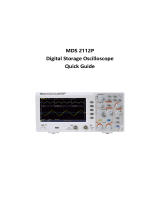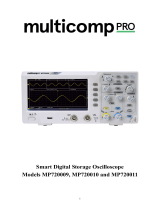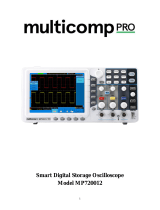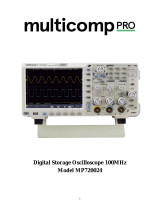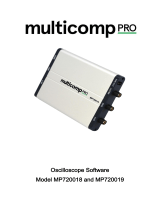
11
V5.1‐March2010
Description of Meter Front Panel and Keypad (Figure 3)
1. AC adapter Port
2. RS-232C Port
3. USB Port
4. USB Mass Storage Port
5. Power switch
6. F1 – F5 Soft-key options
7. AUTO SET: In the Scope mode, the meter automatically selects the
horizontal/vertical scale and trigger level
8. COPY: Press to store the waveform data into a USB storage device
9. ▲ (Red): Adjust the horizontal scale for Channel 1
10. VOLTS POSITION (Red): Switch between voltage and horizontal scales for
Channel 1
11. ▼ (Red): Adjust the horizontal scale for Channel 1
12. ▲ (Blue): Adjust the horizontal scale for Channel 2
13. VOLTS POSITION (Blue): Switch between the voltage and horizontal scales
for Channel 2
14. ▼ (Blue): Adjust the horizontal scale for Channel 2
15. RUN/STOP: Start/Stop the waveform capture process
16. BACKLIGHT: Turn the display backlight ON and OFF
17. DMM/OSC: Operation mode (switch between oscilloscope and multimeter)
18. MENU ▲: Choose a higher item on a menu list
19. MENU: Show / Hide menu
20. MENU ▼: Choose a lower item on a menu list
21. OPTION: Used in combination with the four (4) yellow arrow keys. This
button is used to set the main time base, trigger horizontal position and
trigger vertical position. Also used to adjust the display multiplier factors and
display vertical position during waveform calculation. Further, it is used to
adjust cursor 1 (V1 or T1) and cursor 2 (V2 or T2) position during cursor
measurements
22. ▲ (yellow): Oscilloscope UP arrow adjustment key
23. ▼ (yellow): Oscilloscope DOWN arrow adjustment key
24. ► (yellow): Oscilloscope FORWARD adjustment key
25. ◄ (yellow): Oscilloscope BACKWARD adjustment key
26. A: Selects DMM Current measurement mode
27. V: Selects DMM Voltage measurement mode
28. R: Selects DMM impedance, diode, continuity, capacitance measurement
mode
29. SET: Toggle AC/DC in the current or voltage multimeter measurement
modes; also switches between resistance, diode and capacitance modes
while in the resistance mode.





















